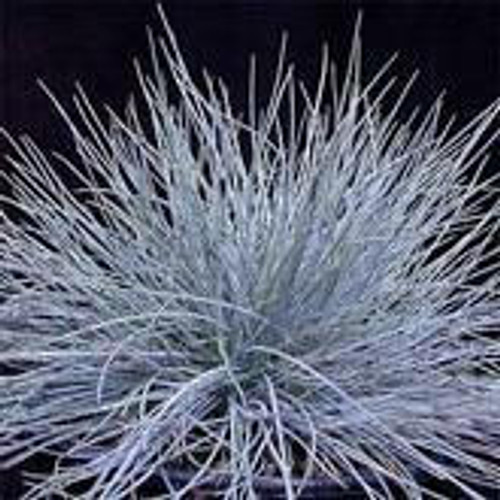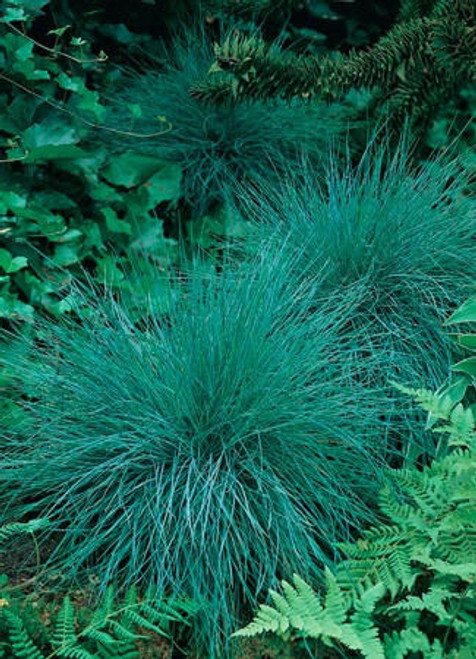Product Description
Festuca glauca - 'Blue Fescue'
Zone: 4 to 8 (10).
Prefers full sun (for best color) but will tolerate light shade.
Mature size: Narrow blade dense clumps reach 4 to 8 inches tall;
Flowers extent to 6 - 10 inch in height.
- Bluish, fine-textured, dwarf ornamental prefers well-drained soil. Flowers in early summer; prune to maintain quality foliage.
- Use as a ground cover, in masses, in the rock garden, or containers. Deer resistant.
- Blue Fescue is a drought tolerant, evergreen that does best in cool, dry climates. It is hardy from zones 4-8 and flowers in summer.
Festuca glauca 'Blue Fescue' is a popular ornamental grass prized for its striking blue foliage and compact, mounding form. It is a fantastic addition to gardens, adding texture, color, and a touch of whimsy. Here is a closer look at what makes it special:
Appearance:
- Foliage: 'Blue Fescue' is known for its eye-catching, silvery-blue foliage. The leaves are fine-textured and form dense, rounded tufts that resemble small, fluffy cushions. The blue color is most intense in spring and early summer and may fade slightly to a blue-green as the season progresses.
- Flowers: In early summer, it produces slender, upright stems that bear airy panicles of light green flowers with a hint of purple. The flowers are not the main attraction but add a subtle, delicate touch.
Growing Conditions:
- Light: Thrives in full sun, needing at least 6 hours of direct sunlight per day for optimal color and growth. It can tolerate some light shade, but the blue color may be less intense.
- Soil: Prefers well-drained soil and is quite drought tolerant once established. It is adaptable to various soil types but performs best in sandy or loamy soil.
- Hardiness Zones: Hardy in USDA zones 4-8, making it suitable for a wide range of climates.
Uses:
- Borders and Edging: Its compact size and mounding habit make it perfect for edging walkways, borders, or garden beds.
- Rock Gardens: It is a natural fit for rock gardens, where its blue foliage contrasts beautifully with the stones.
- Containers: 'Blue Fescue' also works well in containers, adding a touch of texture and color to patios and decks.
- Mass Plantings: Planting it in masses can create a stunning visual effect, resembling a sea of blue.
- Accent Plant: It can be used as an accent plant to add a focal point to the garden.
Additional Benefits:
- Low Maintenance: It is a relatively low-maintenance plant that does not require much care once established.
- Deer Resistant: It is generally deer resistant, so you do not have to worry about deer munching on your plants.
- Evergreen or Semi-Evergreen: In milder climates, it is evergreen, providing year-round interest. In colder regions, its semi-evergreen, with the foliage often turning brown in winter but re-emerging in spring.
Things to Consider:
- Short Lifespan: 'Blue Fescue' can be relatively short-lived, typically lasting only 3-5 years. However, it is easy to propagate by division, so you can create new plants to replace older ones.
- Summer Dormancy: In hot, humid climates, it may go dormant in summer, but it will typically re-emerge in fall.
Overall, Festuca glauca 'Blue Fescue' is a wonderful ornamental grass that adds a touch of unique color and texture to any garden. Its compact size, adaptability, and low maintenance make it a popular choice for gardeners of all levels.
Ten (10) plants in quart containers per flat (or tray).
Other Details
The most important part of the plant is its root system. Healthy roots are the foundation of a healthy, vibrant plant. The type of plug container used is based on the specific needs of the plants. Perennials offered as bare root traditionally perform better when planted as bare root.Planted in a specialized mix, potted plants have well established root systems. Top growth stage will vary depending on the current life cycle and time of year when shipped. In Winter and early Spring dormant plants may be shipped. Dormant plants may be planted right away, even before the last frost date.
Most bare root varieties are field grown for at least one season, though Hemerocallis and Hosta are grown for two seasons. The bulk of the soil is removed during the harvesting process and the tops of most varieties are trimmed back to the crown. They are graded, packed in shredded aspen or sphagnum moss and stored in freezers until ready to be shipped.
See our Container Sizes and Bare Root Perennials pages for more information.
Plant information and care is provided in the Overview section, Plant Genus Page and general information is provided in the Planting Care & Guides. Additional questions can be asked on each Plant page.
Plant Spacing: Using the maximum mature spread or width of a plant to guide spacing, ensures space to grow to full size. To fill an area sooner, plant them closer together. Just remember, future thinning or transplanting may be needed.
Water: Keep a close eye on newly planted perennials, especially throughout the first growing year. Most early plant loss is due to too much or too little water!













